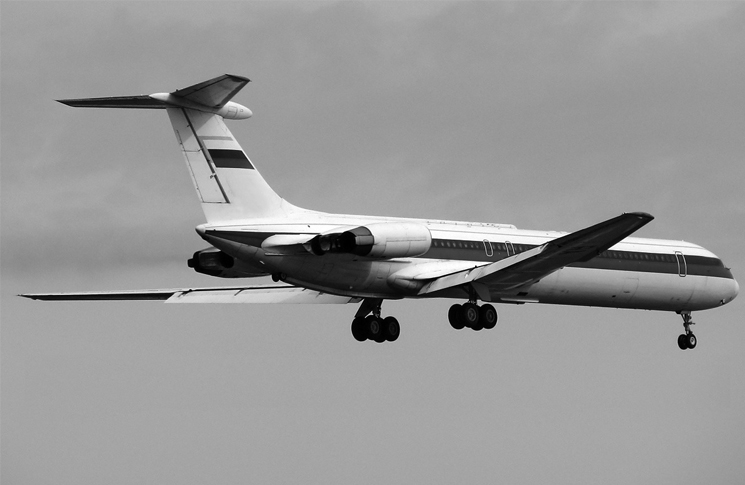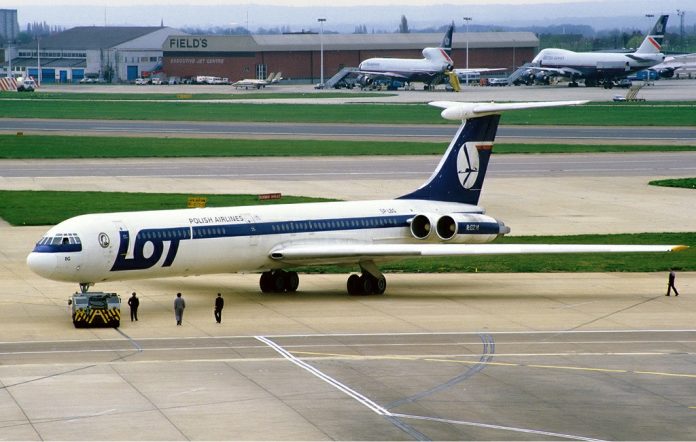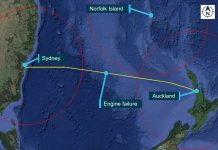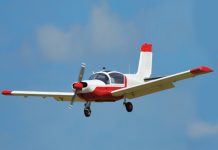A little-known Polish tragedy 30 years ago is an uncomfortable reminder that uncontained engine failures can turn an everyday flight into a dire emergency within seconds.
In the Kabaty Woods, on the outskirts of Warsaw, capital of Poland, there is a stand of trees that are noticeably younger and smaller than those around them. This rectangular scar, measuring 370 x 50 m and clearly visible from the air, marks the place where LOT Polish Airlines flight 5055 crashed on 9 May 1987. It was six km (3.24 nm), or about 50 seconds flying time, from the runway threshold. A simple black cross and a list of names mark the spot.
LOT, Poland’s national airline, had been flying to the US since 1973, although flights had been interrupted by Poland’s period of martial law and had only resumed in 1985. Flight 5055 was bound for San Francisco, with a stop at Kennedy Airport in New York, and carried 38 US residents among its 172 passengers. There were 11 crew, including a flight crew of five and a senior engineer acting as an observer of the flight engineer. The aircraft was a Soviet made Ilyushin 62M, with a remote Australian connection. It was named Tadeusz Kosciuszko, after the 18th century Polish patriot whose name also marks Australia’s highest mountain. The Il62M was a development of the Il62, a T-tailed design with four rear-mounted low-bypass turbofans.
Flight 5055 left Warsaw Okecie airport at 10.18 am on that Saturday morning. Thirteen minutes after take-off, Okecie ATC instructed the heavily laden aircraft to climb to flight level 310 to avoid a military restricted area where training was taking place. The crew complied and set maximum thrust on the four Soloviev engines. Nine minutes later engine no. 2 disintegrated. It was subsequently determined that a shaft bearing had failed, causing a fan disc to separate from the shaft and spin unhindered to a speed where it disintegrated due to centrifugal forces. Fragments of the disc damaged the adjacent no.1 engine and severed flight controls and electrical wiring. Debris also punctured the fuselage and started a fire in a cargo hold.

The CVR recorded an orderly response to the crisis. Translated from Polish it reads:
10.41.30 Crew: ‘Hey! Pressurisation!’
10.41.32 Acoustic ringing signal of cabin decompression
10.41.34 Crew: ‘Is there a fire? What’s going on?’
10.41.35 Crew: ‘Probably a fire.’
10.41.37 Crew: ‘Engine? Shut it down!’
10.41.39 Crew: ‘… shut down. That first one is burning!’
10.41.42 Crew: ‘… fire …’
10.41.44 Crew: ‘…all small’ (referring to engines’ throttles)
10.41.45 Crew: ‘Warsaw?’
10.41.46 Crew: ‘… all small. Decompression.’
10.41.48 Crew: ‘Two engines are gone!’
10.41.49 Continuous acoustic signal of engine fire.
10.41.50 Crew: ‘Two engines are gone! … Shut down … We’re turning around! Fire!’
10.41.55 Crew: ‘Danger. Warsaw radar LOT! Warsaw radar.’
The crew faced fire and loss of thrust in the two left-side engines, cabin decompression and, they soon realised, loss of pitch control. For the remainder of the flight they controlled pitch with the aircraft’s trim system. The flight engineer opened the valves to jettison some of the 70 tonnes of fuel the aircraft was carrying for its trans-Atlantic flight, but was disturbed to see that although the solenoid read as open, the fuel level did not fall. At nearly maximum take-off weight but with only two engines operating, the aircraft was in a gradual, but unstoppable, descent. Among the crew’s terse, unemotional remarks was a brief speculation that something, possibly connected with the military area, had hit the horizontal stabiliser and engines. By this time the fire alarm had ceased and the crew presumed the fire had gone out. The engineer reported only one of the aircraft’s four generators was operational. In response, the captain switched off the radar to save power.
They held a brief parliament about diverting to Modlin, a military airfield northwest of Warsaw. The first officer was in favour, the flight engineer against. The captain decided to go there. There was a slight delay in getting clearance to use the military runway and the captain expressed concern.
‘Come on, do something because our situation is really critical. We must land as soon as possible.’
ATC recordings show the aircraft was cleared to use the airfield. ‘They’re waiting for you in Modlin’, they said, but as they approached the captain had a change of heart. Weather information for Modlin was unavailable and the engineer had managed to get the fuel dump system working, lightening the aircraft by about 30 tonnes and slowing its inexorable sink rate. At about that time there was another explosion towards the rear of the fuselage but no further indications of fire on the flight deck.
At 11:00:23 the captain called Modlin Approach. ‘We’ve decided we’re flying to Warsaw. Warsaw will have better emergency units.’
The captain called Warsaw and advised them of likely problems with the landing gear and flaps, drily adding, ‘For your information, I have no elevator control’.
Warsaw was about 10 minutes flying time away. The captain decided to land on runway 33, which was longer and faced into the 290 degree prevailing wind. The alternative was landing downwind on the shorter, cross runway 11—overweight, with no flaps, and possibly no gear. One thing in his favour was that there was no possibility of flight control hydraulic failure because the Ilyushin 62 did not have hydraulically boosted flight controls. It remains the heaviest aircraft to use the same pulley and cable system as found in a 750 kg general aviation aircraft. Landing on runway 33 required a 180 degree turn. About 11:09 the aircraft was downwind for runway 33, which would have been visible to passengers in the ceiling and visibility OK (CAVOK) conditions.
At 11:09:40 the cockpit voice recorder stopped. All subsequent conversation comes from ATC recordings, including the fatalistic sounding acknowledgement from the captain that the aircraft was on fire.
Captain: ‘Fire is at us once again.’
ATC: ‘You are burning?’
Captain: ‘I think so.’
In fact, the fire had never stopped, and had spread to a cargo hold in the rear of the aircraft. Burning pieces fell from the rear of the aircraft and started small fires in the suburb of Józefoslaw.
The controller, regaining composure, vectored them towards the runaway. At 11:11:02 he said ‘You can start final approach, approximately 11 km from the runway’.
‘We’ll do everything we can’, was the reply from the flight deck. At 11:11:34 the controller cleared the aircraft for Runway 33. The flight deck acknowledged and radio silence followed until an unintelligible transmission at 11:12:10 and five horrifying words three seconds later: ‘Dobranoc, do widzenia, Cześć, giniemy.’ Translated from Polish they mean ‘Goodnight, goodbye, hi, we perish’.
The aircraft crashed into the Kabaty Woods, at an airspeed 250 kt with an 11 degree left bank and 12 degrees pitch-down. No-one survived.
The Polish report into the crash found the shaft bearing in the engine had been installed with half the required number of roller bearings—13 instead of 26. Its failure caused the inner part of the disc to melt and the outer part to spin freely, destroying itself and becoming a rotary projectile. LOT never bought another Soviet aircraft and took delivery of its first Boeing 767 in 1990. Meanwhile, it fitted its Ilyushin 62M fleet with vibration gauges and warning lights.
On 11 March 1990, on a flight from Warsaw to Toronto, one of these yellow warning lights lit up, indicating excessive vibration in engine no. 2. The flight continued on its three remaining engines. Before the Ilyushin 62M went out of service in Poland, there were six occasions when yellow lights glowed and dismantling found bearing wear similar to that seen on flight 5055.
Standard advice for fire in the air is to land as soon as possible, which flight 5055 didn’t do, the crew being unaware of the full extent of the fire. Whether doing so would have assured their survival is far from clear cut, given the fuel load and flight control difficulties the crew was facing. A safe landing at Warsaw seems unlikely, given the aircraft’s speed on final. The accident serves as a yardstick that makes the survival of Qantas Flight 32, 23 years later, seem all the more remarkable. This was a similar initial incident—uncontrolled engine failure—that occurred in a much larger engine, with even greater destructive energy. It was only prevented from being a catastrophe by redundant and robust structure and system design, excellent crew response, and the greatest asset of all—luck.





